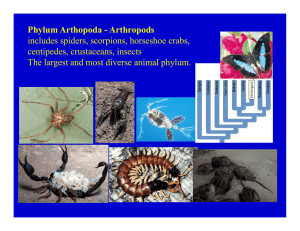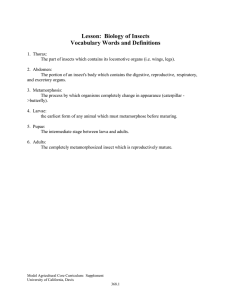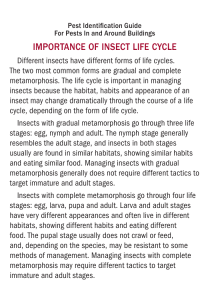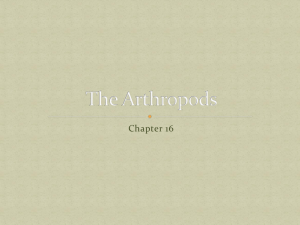Insects Arthropoda Characteristics
advertisement
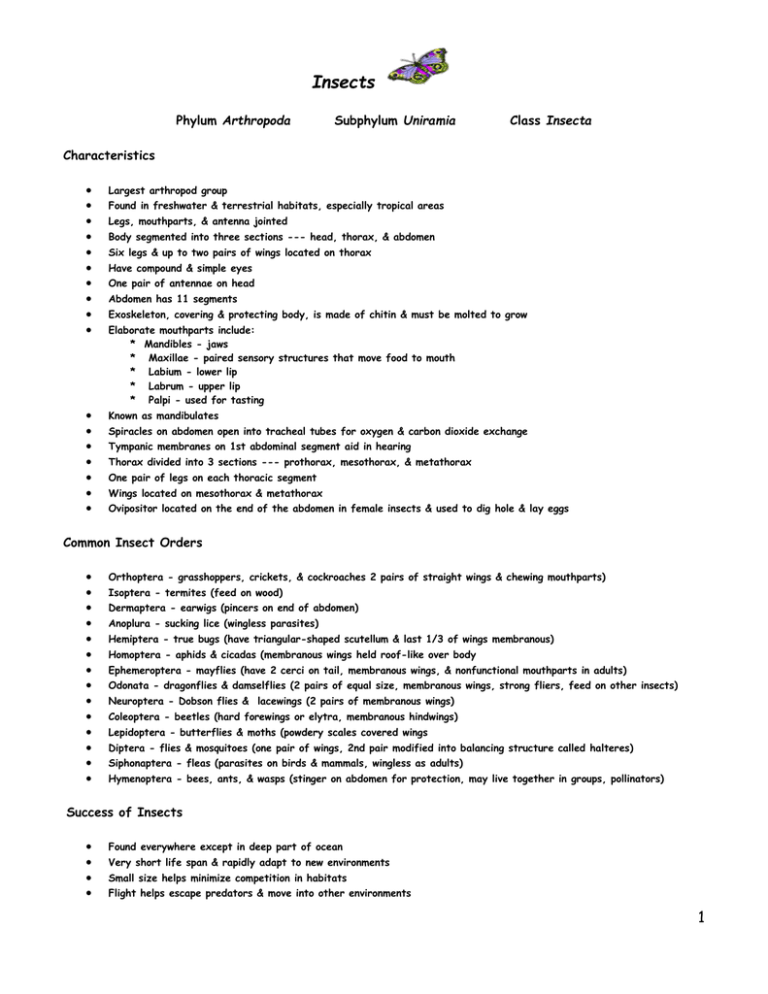
Insects Phylum Arthropoda Subphylum Uniramia Class Insecta Characteristics Largest arthropod group Known as mandibulates Found in freshwater & terrestrial habitats, especially tropical areas Legs, mouthparts, & antenna jointed Body segmented into three sections --- head, thorax, & abdomen Six legs & up to two pairs of wings located on thorax Have compound & simple eyes One pair of antennae on head Abdomen has 11 segments Exoskeleton, covering & protecting body, is made of chitin & must be molted to grow Elaborate mouthparts include: * Mandibles - jaws * Maxillae - paired sensory structures that move food to mouth * Labium - lower lip * Labrum - upper lip * Palpi - used for tasting Spiracles on abdomen open into tracheal tubes for oxygen & carbon dioxide exchange Tympanic membranes on 1st abdominal segment aid in hearing Thorax divided into 3 sections --- prothorax, mesothorax, & metathorax One pair of legs on each thoracic segment Wings located on mesothorax & metathorax Ovipositor located on the end of the abdomen in female insects & used to dig hole & lay eggs Common Insect Orders Orthoptera - grasshoppers, crickets, & cockroaches 2 pairs of straight wings & chewing mouthparts) Isoptera - termites (feed on wood) Dermaptera - earwigs (pincers on end of abdomen) Anoplura - sucking lice (wingless parasites) Hemiptera - true bugs (have triangular-shaped scutellum & last 1/3 of wings membranous) Homoptera - aphids & cicadas (membranous wings held roof-like over body Ephemeroptera - mayflies (have 2 cerci on tail, membranous wings, & nonfunctional mouthparts in adults) Odonata - dragonflies & damselflies (2 pairs of equal size, membranous wings, strong fliers, feed on other insects) Neuroptera - Dobson flies & lacewings (2 pairs of membranous wings) Coleoptera - beetles (hard forewings or elytra, membranous hindwings) Lepidoptera - butterflies & moths (powdery scales covered wings Diptera - flies & mosquitoes (one pair of wings, 2nd pair modified into balancing structure called halteres) Siphonaptera - fleas (parasites on birds & mammals, wingless as adults) Hymenoptera - bees, ants, & wasps (stinger on abdomen for protection, may live together in groups, pollinators) Success of Insects Found everywhere except in deep part of ocean Very short life span & rapidly adapt to new environments Small size helps minimize competition in habitats Flight helps escape predators & move into other environments 1 Environmental Impact Pollinate almost 2/3's of all plants Serve as food for fish, birds, & mammals Help recycle materials (termites recycle wood) Make useful byproducts such as silk & honey Some spread disease Agricultural pests Grasshoppers External Structure Head with antenna, compound eyes, & chewing mouthparts Walking legs on prothorax & mesothorax; jumping legs on metathorax Tarsus are lower leg segments with spines, hooks, & pads Leathery, protective forewings on mesothorax & membranous hindwings for flight on metathorax Covering over thorax called pronotum Internal Structure Digestive & Excretory Systems Cutting & chewing mouthparts (labium, labrum, mandibles, & maxillae) Saliva added to food in mouth Esophagus carries food to crop for temporary storage Gizzard has chitinous plates to grind food Midgut (insect's stomach) has gastric caeca (pouches) to secrete digestive enzymes to break down food Food is absorbed into the body cavity or coelom in the hindgut (composed of the colon & rectum) Malpighian tubules filter chemical wastes from the blood & deposit them in the rectum where they leave through the anus 2 Circulatory System Open circulation of blood Aorta is the largest blood vessel carrying blood to the body cells Hearts are muscular regions of the aorta in the posterior end of the abdomen that pump blood toward head Blood flows back toward abdomen carrying digested food & re-enters the aorta through openings called ostia Respiratory System Air enters through openings called spiracles along the sides of the abdomen & enters into tracheal tubes that branch into smaller tracheoles where gas exchange with body cells occurs Tracheal tubes carry oxygen to body cells & return carbon dioxide to leave the body though spiracles Nervous System Simple brain, nerve cords, & ganglia Three simple eyes or ocelli (detect light) & a pair of compound eyes (can detect movement but not images) Tympanic membrane on 1st abdominal segment Pair of antenna contains sense organs for touch, taste, & smell detects sound Sensory hairs found on parts of the body Palpi for taste Reproductive System Reproductive organs (ovaries & testes) located in abdomen Male deposits sperm into female's seminal receptacle Stored sperm fertilizes eggs as they are released by female Ovipositor on tip of female's abdomen is used to lay eggs Separate sexes Lay large number of eggs to ensure survival Development Most insects go through changes in form & size called metamorphosis Some insects such as silverfish don't go through metamorphosis Incomplete metamorphosis goes from egg to nymph (immature form that looks like adult but without fully developed wings) to adult (3 stages) 3 Instars are growth periods between molts of nymphs & larva Grasshoppers, termites, & true bugs go through incomplete metamorphosis HEMIPTERAN (TRUE BUG) NYMPH Complete metamorphosis goes from egg to larva (segmented & wormlike) to pupa to adult (4 stages) BUTTERFLY LARVA (CATERPILLAR) Butterflies, beetles, & flies go through complete metamorphosis In pupal stage, larval tissues break down & cells called imaginal disk develops into tissues of the adult Cocoon or chrysalis is a protective case formed around the pupa BUTTERFLY COCOON Metamorphosis controlled by hormones * Brain hormone stimulates the release of molting hormone (ecdysone) * When juvenile hormone level high, larva molts * When juvenile hormone level low, larva pupates * When juvenile hormone absent, adult emerges from pupal case Different stages of metamorphosis eliminates competition between larva & adults for food & space Multi-stage life cycle helps insects withstand harsh weather Different stages have different functions (caterpillar/growth & adult/reproduction) Defense Mechanisms Bombardier beetle sprays noxious chemical BOMBARDIER BEETLE 4 Wasps & bees can sting Some insects use camouflage to blend into their environments Some insects taste bad & have warning colorations PAPER WASP Mullerian mimicry - poisonous or dangerous species have similar patterns of warning coloration so predators avoid all the species (black & yellow stripes on bees & wasps) Batesian mimicry - species that are nonpoisonous or not bad tasting have colorations that mimic other poisonous or bad tasting species (Viceroy butterfly mimics bad tasting Monarch) Insect Communication Insects may communicate with each other using sound (cricket chirps), light (firefly), or "dances" (honeybee) Pheromones are chemicals released by some insects to attract mates or mark trails Insect Behavior Insects may be solitary or social Social insects (bees, ants, & some wasps) live together in groups & share work (division of labor) Social insects have a caste system with different individuals doing different jobs Honeybee caste system: * Workers - sterile females - care for queen & feed her honey and pollen make beeswax for hive fan wings to cool hive eat honey collect nectar, pollen, & royal jelly live about 6 weeks nurse bees care for larva secrete royal jelly to feed new queen * Drones - males - mate with queen - feed by workers - driven out of hive to conserve food during winter * Queen - reproductive female - mate only once but store sperm for up to 5 years in seminal receptacles - feed by workers - secretes chemical called queen factor that prevents other females from sexually maturing - leaves hive with 1/2 the workers if there is overcrowding HONEYBEE HIVE 5
